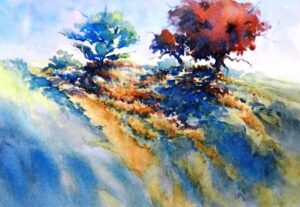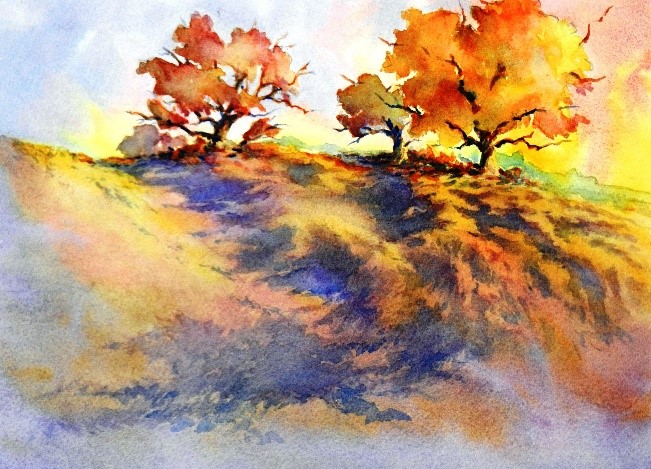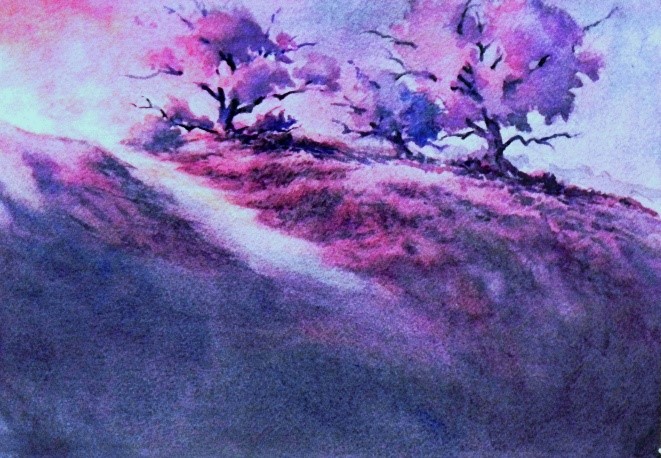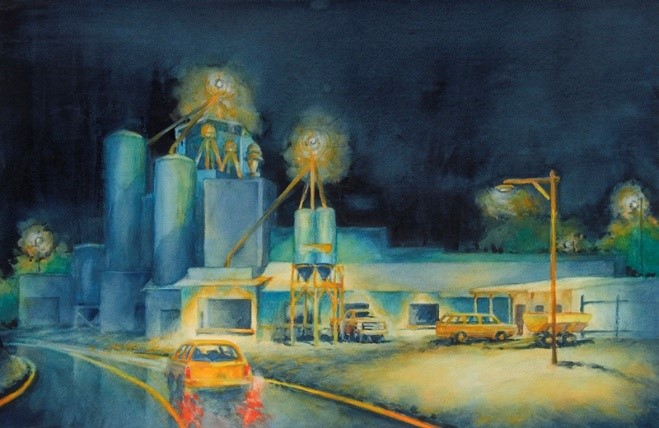 17 April 2025
17 April 2025
6) The Color of Light Using Watercolor
The color of light is a crucial element in paintings to create mood and emotion. Understanding how the color and quality of light changes throughout the day is essential knowledge for watercolor painters whose goal is to tell a story with their paint. Each time of day brings distinct lighting conditions, which influence the colors you see and, therefore, the colors you should use in your paintings. Let’s take a look at the color of light throughout the day:
Early Morning
- Light is gentle and often has a soft, yellow cast.
- Shadows are long and edges are less defined.
- Moisture in the air scatters blue and violet wavelengths, allowing more yellow light to dominate.
- Greens and yellows appear fresh and luminous, with a subtle warmth that distinguishes morning from evening light.
- The sky may show cool blues near the horizon, with hints of pink or rose from the rising sun.
“Mid-day Light”,
watercolor, 15” X 11”
Noon
- Light is at its brightest and most neutral.
- The sun is high, so shadows are short and colors appear less saturated.
- The overall color of light is cooler—think silvery or slightly bluish white.
- The full spectrum of sunlight is present, but the intensity can wash out subtle color differences, making scenes appear flatter and less dramatic.
- Surfaces may seem more reflective, and contrasts are sharper.
Late Afternoon
- Light becomes warmer and more golden as the sun lowers.
- Shadows lengthen, and colors become richer and more saturated.
- Oranges and reds start to appear in the light, especially on sunlit surfaces.
- The sky can shift from blue to warmer tones, and the landscape may take on a glowing quality1
- This is a favored time for many painters due to the dramatic interplay of warm light and cool shadows.
“Late Afternoon”,
watercolor , 15” X 11”
“Early Evening”,
watercolor, 15” X 11”
Early Evening (Golden Hour & Dusk)
- The warmest light of the day, with strong orange, red, or even magenta hues.
- Shadows are long and cool, often tinged with blue or violet.
- The sky may display a gradient from warm near the horizon to cooler blues above.
- Colors in the landscape become more intense, and atmospheric effects (like haze or mist) can add softness.
- As the sun sets, the overall brightness decreases, but color contrasts can become more pronounced.
Night
- Natural light is minimal; moonlight or artificial lights dominate.
- Colors are subdued, with a general shift toward cool blues and grays.
- Shadows are deep and edges are less distinct.
- Artificial lights can introduce warm spots of yellow or orange, creating dramatic contrasts with the surrounding darkness23.
- The sky may range from deep blue to black, and only the brightest colors stand out.
“Evening At Lindner Feed and Mill”,
watercolor, 22” X 15”
By capturing the unique characteristics of light at different times of day, you’ll add depth, atmosphere, and emotion to your watercolor paintings. Experiment with color and light to convey the essence of your subjects.
Do you see the changes and emotions that color and light produce in watercolor?

![]() 17 April 2025
17 April 2025



